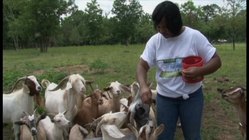Narrator (Susan Carter): Helping the unemployed find jobs. Getting started in goat farming. And better bulbs at U-S-D-A. Those stories and more in "U-S-D-A Week In Review". Narrator: U-S-D-A is helping people using the Supplemental Nutrition Assistance Program, or SNAP, find jobs and make more money. Secretary Vilsack says two hundred million dollars is available to state SNAP agencies to create employment and training projects.
Tom Vilsack, Agriculture Secretary: Taking a look at those able-bodied individuals who are looking for work, who want work, who may be part of that long-term unemployed that is having a harder time in this improving economy finding work. Let's do a better job of connecting those individuals to work opportunities.
Narrator: SNAP offers nutrition assistance to millions of eligible, low-income individuals and families and it's the largest program in the domestic hunger safety net.
Narrator: Meantime, Secretary Vilsack is calling for efforts to better protect public forests from wildfires. He says more attention should be paid to keeping forests unaffected by diseases and insects.
Tom Vilsack, Agriculture Secretary: That should reduce the risk of fire and the intensity of the fires in the future, which should obviously lower the costs of fighting fires. So it's really an ounce of prevention is worth a pound of cure. We've been really focused more on the pound of cure. I think it's time now to rebalance and restructure.
Narrator: He says firefighting has taken up dramatically more of the Forest Service budget as the wildfire season increases.
Narrator: Former college provost Beverly Robinson wanted to start a goat farm in Georgia, so she turned to U-S-D-A's Natural Resources Conservation Service for help.
Vontice Jackson, District Conservationist, USDA NRCS: Luckily at the time through our EQIP program, we were able to come in and provide her some assistance to help put up better fencing that meets our standards and specifications. And in doing so, we were able to provide her with a better grazing system.
Beverly Robinson, Farmer, Soperton, Georgia: I'm ecstatic about the assistance I've received from NRCS. Because of the assistance we've received, we're ready to go and I'm comfortable that I'm putting quality and healthy meat out there on the market.
Narrator: Robinson raises forty goats on her ten acre Robinson House farm in Soperton, Georgia.
Narrator: U-S-D-A is making the switch to new L-E-D lights in its buildings. The new lights are as bright or brighter than old lights and last longer.nclude any additional information you have here.
Ed Murtagh, USDA Sustainable Operations Manager, Office of Operations: By reducing the number of lightbulbs we use, by being more energy efficient, by using less hazardous materials, we can greatly reduce the environmental impact.
Narrator: Switching to L-E-D's is part of U-S-D-A's greening and sustainability efforts.
Narrator: And in this week's Photo of the Week, here is rancher John Bushell with one of his horses on his ranch near Dade City, Florida. The Natural Resources Conservation Service, N-R-C-S, helped Bushell improve fencing and rotational grazing on his spread. Check out the U-S-D-A blog for more on Bushell's fifty acre conservation project entitled "U-S-D-A Conservation Plan Helps Florida Ranchers Afford to Protect and Serve a County. For more images visit the U-S-D-A Flickr Photostream. That's all for "U-S-D-A Week In Review". Follow, tweet, and stay informed at U-S-D-A dot-gov. |



No comments:
Post a Comment